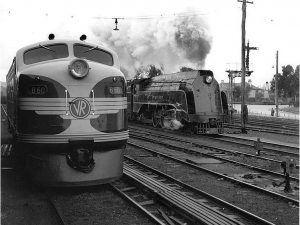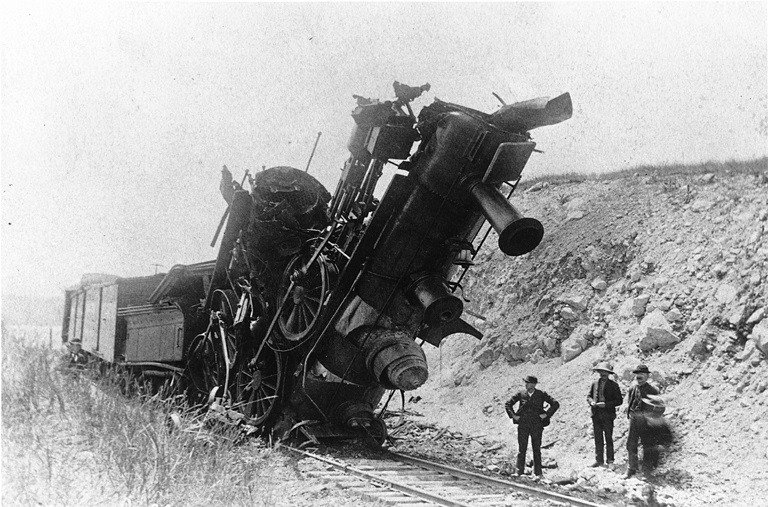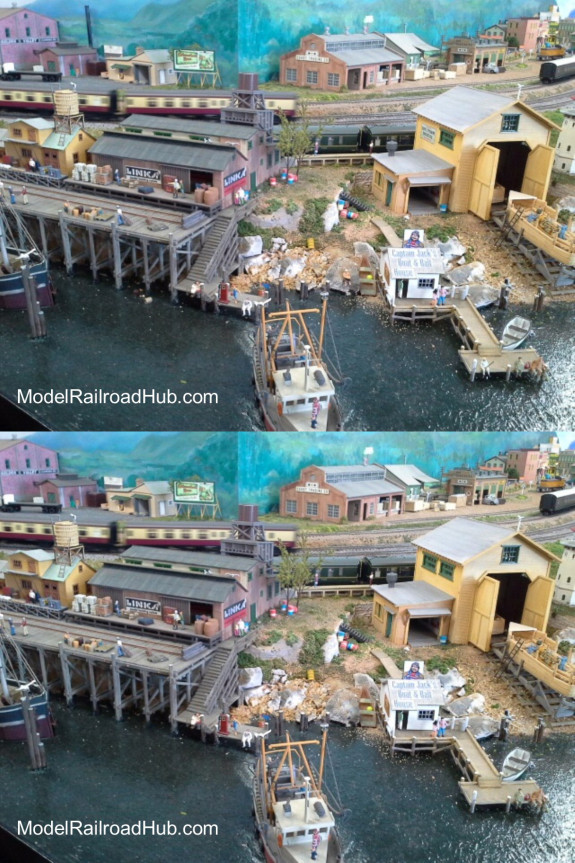Others
Everything on model trains, model railroads, model railways, locomotives, model train layouts, scenery, wiring, DCC and more. Enjoy the world's best hobby... model railroading!
Rich W kindly sent in these photos of a couple of house plans he downloaded from the modelbuildings.org website
Here’s what Rich had to say – “I mentioned I would send a few pictures. These is first shots of section before getting put on the layout. I still have some more details to do, but thought you might like to see these. Yes, I cut the windows out and used non glare tape inside the houses. Because of space I had to hang a few near the edge of cliff and so with the texture sheet I made the decking, and cut wood to make the railings. Thanks again.”
http://www.modelbuildings.org/scale-houses-8-house-models-to-make.html
 Victoria, Australia 1952. Victorian Railways new diesel electric B 60 locomotive being delivered to Melbourne passes one of the S class ‘Pacific’ steam locomotives it eventually replaced.
Victoria, Australia 1952. Victorian Railways new diesel electric B 60 locomotive being delivered to Melbourne passes one of the S class ‘Pacific’ steam locomotives it eventually replaced.
The B class were the first mainline diesel locomotives and were used for both passenger and freight services.
The design was based around the successful Electro Motive Diesel F-unit locomotives with a distinctive bulldog nose. They featured a streamlined drivers cab at each end.
As regular readers will know, this blog does not do buy/sell/swap of used model railroading trains and accessories. We leave that to model train shows, and websites like eBay and Craigslist etc.
That said; we are often asked to put a value on how much second hand items might be worth. That’s not something we do. Obviously there are potentially a lot of factors at play including the condition of individual items, the location of the buyer and seller, the likely demand for each item, the cost of shipping etc.
The only real answer is that a secondhand item is worth what someone is prepared to pay on any given day. That’s why a visit to a local hobby shop, or model train club is often a worthwhile way to ascertain the level of interest in an item. Even if they don’t want to purchase the product, they can at least see its condition in real life, maybe test how well it works, give an estimate of what they think someone might pay, and perhaps some advice on how to go about selling it. Talking with vendors at model train shows is another way to gain a better insight.
From a buyer’s perspective; buying second hand goods can be fraught with danger without actually seeing the product and testing it out. But it could also be a golden opportunity to grab a real bargain.
Here’s an example of a recent email from John K. Obviously to protect the privacy of readers we don’t publish email or physical addresses or phone numbers, but readers can post an opinion on this blog of what they think these items might be worth if sold privately.
John who models 3/16 scale wrote: “I have one instruction book 1954, 20 curved sections of track, 6 strait sections, 2 696 track trip, 1 704 manual track trip, 1 overpass 24 pieces, 1 steam engine and tender needs repairs, 1 flatcar with logs, 1 empty car, 1 caboose 938, 1 industrial crane browning hoist 944, 1 road sign with sound, and 1 transformer. Is there any value to this set and how much should I advertise it for?
Photo credit: http://lefunny.net
With so many railroads around the world it’s not surprising the strangest things happen at times. Sometimes with tragic consequences and often with just damage to track/trains and inconvenience, not to mention the financial cost of putting things right. This photo is one such example…not an easy problem to fix.
Perhaps readers could suggest how this collision might have happened, and/or the likely process for rectifying the problem. Also if you just want to add a funny caption then go ahead.
Add your comment and view contributions from others by using the COMMENTS link.
 The Bay of Quinte Railway was a small regional rail line located in Hastings County, ON, Canada. This unusual photo shows a collision between two engines back in 1892.
The Bay of Quinte Railway was a small regional rail line located in Hastings County, ON, Canada. This unusual photo shows a collision between two engines back in 1892.
How you you think it happened? Add your comments below.
Our readers like funny captions so, if you are feeling creative, you are welcome share one for everyone to enjoy.
Brock says he models HO/OO and asks:
“I Model Chester station in the U.K. but I live in the USA. I need advice to create prototypical operations and details. Also, has a USA freight car ever been in use in Britain?”
Fred P kindly sent in this amazing photo he shot and says, “I have this back in the day photo to share with you guys. This photo is on The Northeast Corridor.”
Comedian Buster Keaton was a pioneer of silent comedies in the 1920’s.
Keaton loved trains and had Stephenson’s Rocket recreated along with just on a mile of rickety track just for this film. Will the train stay on the track? It is kinda crazy, but an historic masterpiece.
Add your comment below.
Add your funny caption to this photo by using the COMMENTS link. You can also see what others had to say in the COMMENTS section.
Central Japan Railway has revealed a prototype of the N700S, a “Supreme” bullet train that has been designed to be kinder to both the passengers and the environment. It’s claimed to 20 percent lighter, consumes at least 7 percent less energy and has a ‘boxier’ nose to cut back on the sonic boom-like effect when the bullet train rushes through tunnels at up to 300KPH (186MPH).
See if you can spot the 9 differences in these two pictures of scale model people and houses. Add your answers using the COMMENTS link directly below this posing.
Have Fun!
Plans for the scale model houses are available here.
Johnny models HO and asks this interesting question:
“Back in the early 1960s I had some track for my HO scale train that consisted of a wooden bed that had sections (app. 3 ft. long) and rails that were one piece (app. 4 ft. long) that you used miniature spikes to install the rails to the bed. I don’t see this being used anymore. Am I remembering something that is of my imagination or has anyone else ever seen this type of track?”
Add your comment below this posting.
I’m now retired and have been researching everything needed to build an HO layout in a 12 x 9 space. I’m new to this E-Bay thingy.
1] What to look for when shopping for diesel Locos on E-Bay?
2] Any reputable E-Bay store recommendations that anyone can share w/me & others.
I live in Philly, and am not sure whether I have necessary skills to build a complete layout from start to finish, so need recommendations for reputable layout designer/builders on the east coast.
I have many more questions and appreciate any advice given.
5 FREE Calculators – Click Here
Use the buttons below to share this posting with your friends on Facebook, by email etc.
Rick who models N scale has this question for others in the hobby:
“I was wondering if there was an easy way to shape arms, legs and bodies to suite different scenes. Such as a camp fire sit, or bending to pick something up, etc.”
Add your COMMENT below.
One of the keys to success in creating your perfect layout – the one you always dreamed of owning, is knowing exactly what you want… or more importantly, what aspects of the hobby give you the most pleasure.
Is it building magnificently realistic scenery, planning and laying track, or managing realistic train operations? Given the choice; would you prefer more yard switching, or mainline operations? There is no right or wrong answer – we all look for different things.
For most layouts you can’t really treat each of the above in isolation. To a certain extent they interrelate, and the emphasis you place on one aspect of your layout will potentially affect what happens to another aspect of your layout.
It is a case of knowing what YOU want, and what YOU enjoy most, and then deciding the “Relative Emphasis” you’ll place on each aspect of your railroad. After all most of us have limited space available, so prioritizing each aspect of the layout is a necessary part of the hobby.
For example; if you like a lot of track work, then you might need to limit the space allocated to scenic features like rolling farmland, or maybe a harbor scene, or mountain range.
Here’s where these two sliding cursor drawings will come in handy to help define and clarify your ideas.
How to Use These Charts to Create a Better Layout
Lo oking at the first drawing (the blue one), imagine you could move the cursor to the left or right. Moving the cursor to the left would place more emphasis on having more scenic realism on your layout; and moving the cursor to the right towards the track / operation end will potentially be at the detriment of scenic realism. On your perfect layout, where would you place the imaginary cursor – at number 1, 2, 3, 4, 5, 6, 7, 8, 9, or maybe at number 10?
oking at the first drawing (the blue one), imagine you could move the cursor to the left or right. Moving the cursor to the left would place more emphasis on having more scenic realism on your layout; and moving the cursor to the right towards the track / operation end will potentially be at the detriment of scenic realism. On your perfect layout, where would you place the imaginary cursor – at number 1, 2, 3, 4, 5, 6, 7, 8, 9, or maybe at number 10?
Similarly, on the orange drawing, imagine you could move the cursor to the left meaning your ideal layout would include more switching operations; or you could move the cursor to the right indicating you would prefer more mainline running. The imaginary sliding cursor won’t actually move, but it will help you get your operating balance right.
 This is a great exercise to help clarify the mind, and decide which direction you want your layout to take.
This is a great exercise to help clarify the mind, and decide which direction you want your layout to take.
Use the buttons below to share this posting with your friends on Facebook, by email etc.
It’s been a long time since we had a Spot The Difference puzzle. The last series was really popular with readers, so I hope you enjoy the challenge of this latest photo. I counted seven differences – see how many you can find. Enjoy!

You can add your answers by using the COMMENTS link below.